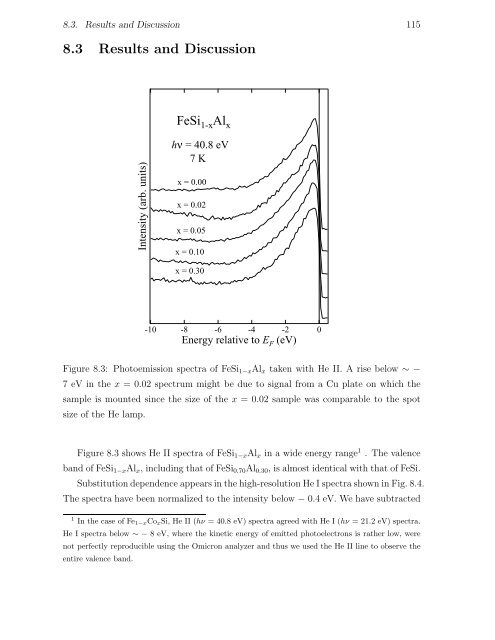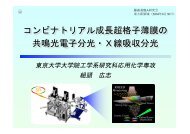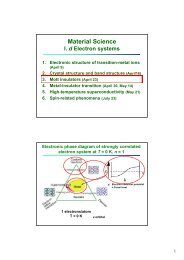Thesis High-Resolution Photoemission Study of Kondo Insulators ...
Thesis High-Resolution Photoemission Study of Kondo Insulators ...
Thesis High-Resolution Photoemission Study of Kondo Insulators ...
You also want an ePaper? Increase the reach of your titles
YUMPU automatically turns print PDFs into web optimized ePapers that Google loves.
8.3. Results and Discussion 115<br />
8.3 Results and Discussion<br />
Intensity (arb. units)<br />
FeSi 1-x Al x<br />
hν = 40.8 eV<br />
7 K<br />
x = 0.00<br />
x = 0.02<br />
x = 0.05<br />
x = 0.10<br />
x = 0.30<br />
-10 -8 -6 -4 -2 0<br />
Energy relative to E F (eV)<br />
Figure 8.3: <strong>Photoemission</strong> spectra <strong>of</strong> FeSi1−xAlx taken with He II. A rise below ∼−<br />
7 eV in the x = 0.02 spectrum might be due to signal from a Cu plate on which the<br />
sample is mounted since the size <strong>of</strong> the x = 0.02 sample was comparable to the spot<br />
size <strong>of</strong> the He lamp.<br />
Figure 8.3 shows He II spectra <strong>of</strong> FeSi1−xAlx in a wide energy range1 . The valence<br />
band <strong>of</strong> FeSi1−xAlx, including that <strong>of</strong> FeSi0.70Al0.30, is almost identical with that <strong>of</strong> FeSi.<br />
Substitution dependence appears in the high-resolution He I spectra shown in Fig. 8.4.<br />
The spectra have been normalized to the intensity below − 0.4 eV. We have subtracted<br />
1 In the case <strong>of</strong> Fe1−xCoxSi, He II (hν = 40.8 eV) spectra agreed with He I (hν = 21.2 eV) spectra.<br />
He I spectra below ∼−8 eV, where the kinetic energy <strong>of</strong> emitted photoelectrons is rather low, were<br />
not perfectly reproducible using the Omicron analyzer and thus we used the He II line to observe the<br />
entire valence band.






